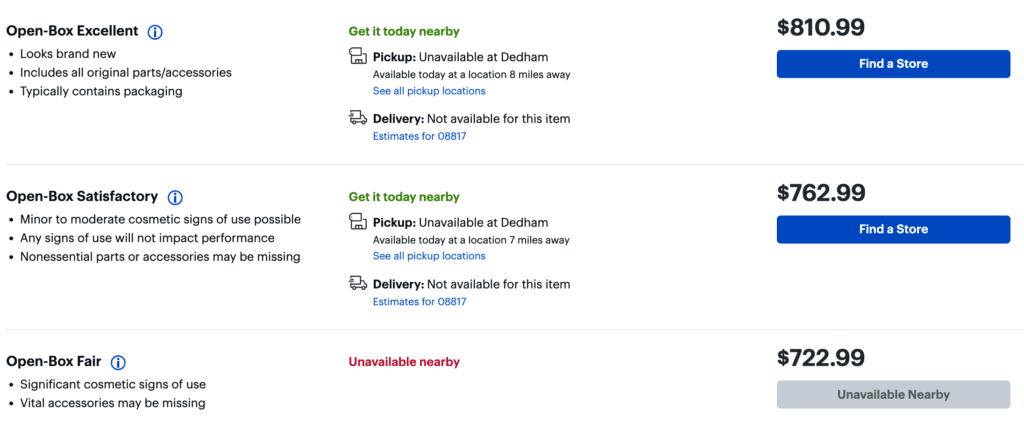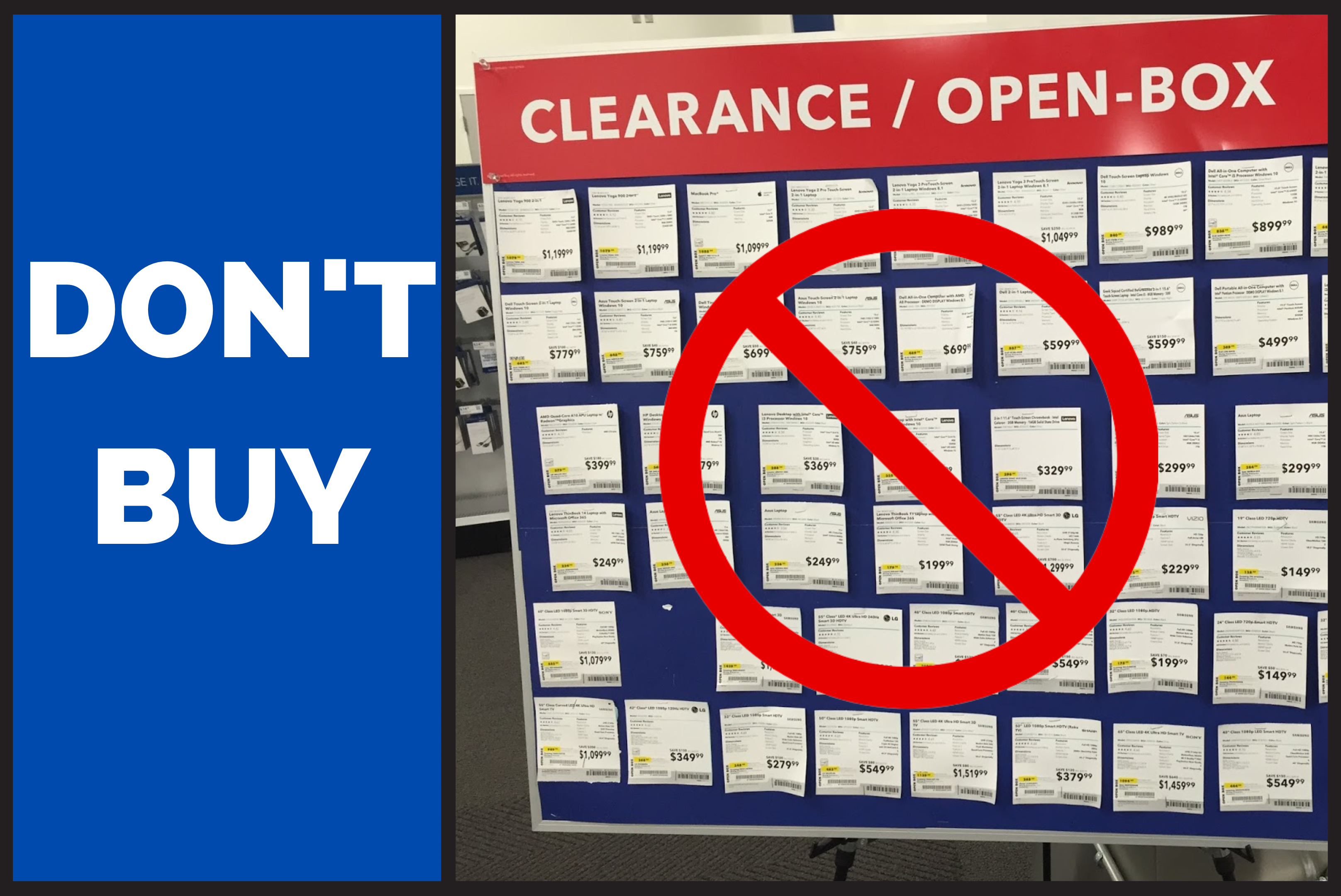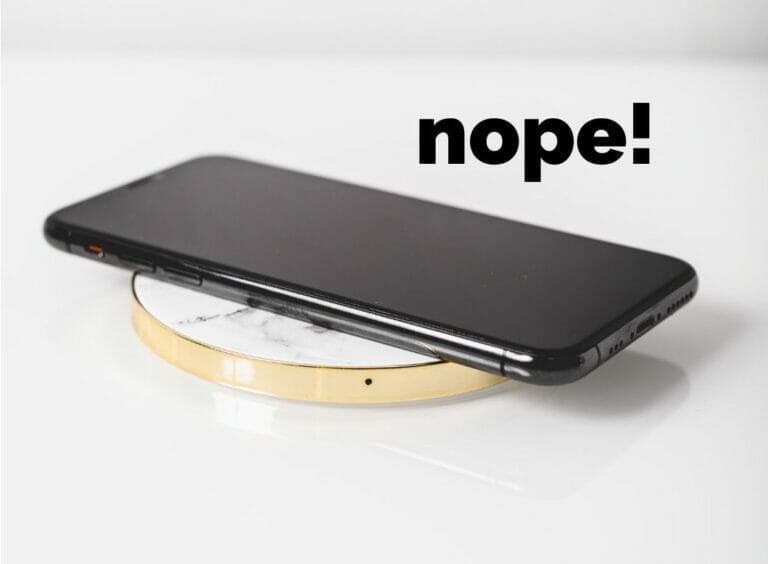Here’s why I won’t buy a Best Buy Open Box product
When I was shopping for a TV recently, I explored a lot of buying options. I didn’t want to pay full price and was getting impatient waiting for sales. So I kept checking retailers, Craigslist, Marketplace, and anywhere else I might be able to get a deal. Eventually, I started reading about how Best Buy has “Open Box” deals, where they offer used products at a discount. Generally when you hear “open box,” you might think of a product that was opened and then returned. Well, in my experience this was not the case at all. Luckily an associate saved me from buying a product thats condition was misrepresented, and now I avoid open box items in almost all cases.
How does Best Buy define Open Box?
Before I get into what happened to me, here is a primer on what Best Buy says all of the conditions mean:
Excellent Certified.
Each Excellent-Certified product has passed the Geek Squad® Certified process involving a rigorous multipoint inspection designed to ensure the highest performance and quality standards. Each product is tested to verify it works like new and is restored to original factory settings. Products in this condition look brand new — with no physical flaws, scratches or scuffs — and include the original parts and accessories (or a suitable replacement), as well as the original box (or a suitable replacement).
Excellent.
Products in Excellent condition look brand new — with no physical flaws, scratches or scuffs — and include all original parts and accessories (or a suitable replacement). The product will be in its original box (or a suitable replacement).
Satisfactory (in-store or Store Pickup items).
Products in Satisfactory condition show minor to moderate signs of use that affect cosmetic appearance, but have no impact on performance. If the product has a screen, it is intact and fully functional, with no visible blemishes in the viewing area. (A Satisfactory product does not include dents, chips, cracks or deep scratches.) In addition, original packaging is typically not present, and parts or accessories might be missing.
Fair (in-store or Store Pickup items).
Products in Fair condition operate as intended, but show more significant scratches, dents or chips — for example, an appliance returned to a Best Buy store with a dent or large scratch or a TV with a minor scuff on the screen that doesn’t affect viewing quality. Original packaging is typically not included, and accessories are commonly missing. If you can accept visible flaws, you’ll also realize substantial savings.
*Open-box condition:
Common home delivery products such as TVs and major appliances may still qualify for Excellent-Certified or Excellent condition without packaging.
Right away, I’m left wondering why both “excellent conditions” say that they include the box, and then the asterisk basically says “we don’t have to give you a box.” That’s not even my larger concern. My concern is a lack of information about how the product was used.
The TV I wanted was a TCL 65R656, which was on sale for $799 new. This meant that the open-box deals were even less than that. I found a listing for an “excellent” condition one, so I assumed it was a like new TV, or a return. Unfortunately, the only one available was a bit of a drive. My mom happened to be in town, so I enlisted her help since she had a car that would actually fit the TV. After a 45 minute ride we arrived, and I raced over to the TV section. What the very honest sales associate told me was that the TV was the Best Buy display model, and had been powered on for over a year and a half, 24 hours a day! I asked him if that was bad, and his response was a solemn “yes.” The price was only about $120 less than a new one. LEDs last a long time, but in the end they are just tiny lightbulbs. Lightbulbs won’t last forever, so having them on constantly like that is not good for longevity. Imagine buying a car that looked really new, had no scratches or rust or anything, but had 120,000 miles on it. They sold it to you for 10% off and said it was “excellent” and sent you on your way. This is basically what they were trying to do here.

What was most infuriating is I thought I had figured out how the TVs were supposed to be labeled after hours of research. It didn’t say that this was a requirement anywhere, but some TVs were labeled as display models. They would have a photo of the TV in the store, and were categorized as fair or satisfactory. This TV was not labeled as a display model, and did not even have the remote or TV stand as an “excellent” TV should. When I asked for an explanation from the associate (I kept my cool, he was super chill and open about everything), he told me that all of this just depends on who inventoried the TV. He admitted that it should be a lower condition, but that it really just depends on who the associate was that day that was working that day. There is no actual requirement to label the TV as being a display model on the website, as I had assumed was the case since some of them were labeled as such.
I could easily imagine a scenario where I went to buy the TV, and perhaps it was even in a box, and I just gladly bought it because the associate didn’t tell me it was a display model. The final insult would be that I would have only saved about $120 (less now, it’s only $40 off from new)! At this point, why even call it open box? It was taken out of the box almost two years ago and used the entire time since then.
Here are my takeaways:
- If you really want to buy a used TV, wait patiently for it to appear on Marketplace or Craigslist.
- If for whatever reason you really want to buy a Best Buy Open Box, be careful! Ask a lot of questions, such as “who used it” and “was it a display model?” Also, check the Google and Yelp reviews for that specific store to make sure they don’t have a reputation for shady behavior.
- Best Buy should have more stringent requirements, or at least accurate labels on their website. Furthermore, re-name “Open Box” to just “used.”
Open-box can be better for some other types of products, such as audio equipment and other items that age differently. Some products don’t have display models, so this wouldn’t be a concern. But for others, it’s a complete roll of the dice. I ended up buying it new from Amazon for $799, and I feel a lot more secure knowing that it’s brand new. This could be a fluke, and of course, this is anecdotal. But after my experience, I have no interest in pursuing this option again.




